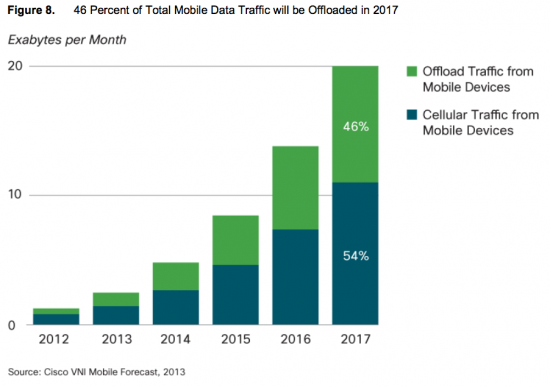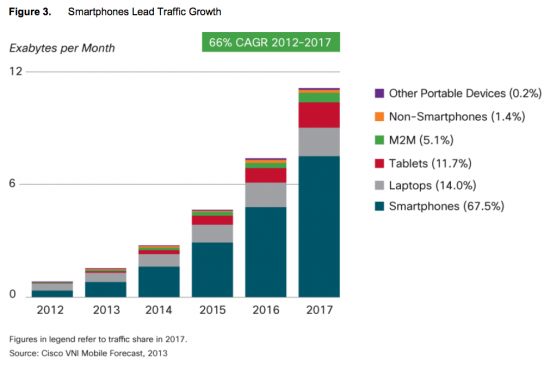































For the fifth year, Cisco has released its updated Mobile Visual Networking Index Forecast. This year, we've seen dramatic changes in consumer behavior as well as continued explosive growth in mobile data.
Global mobile traffic grew 70% in 2012 and traffic is forecast to rise 13 times between 2012 and 2017, a CAGR of 66%. And in 2012, for the first time, video exceeded 50% of global mobile data.
The key take away from this year's report, however, is the dramatic shift of mobile traffic offloaded to small cells, primarily Wi-Fi. The chart below (Figure 8 from the mobile VNI report) illustrates how mobile offload increases from 33 percent of total mobile traffic (cellular plus small cell/ Wi-Fi) in 2012, to 46 percent in 2017. This is significantly larger than we forecasted just a year ago when we estimated mobile offload would comprise 11% of total traffic in 2011, growing to 22% in 2016.

Offloading is even more pronounced in the US where it will account for 66% of total mobile traffic in 2017.
While the underlying aggregate global mobile data traffic, cellular plus Wi-Fi, has been revised slightly from last year (2012 total traffic revised to 1.3 exabytes from 1.5 exabytes/month; 2016 traffic revised to 13.8 exabytes from 13.9 exabytes), the shift from cellular to Wi-Fi is occurring faster than we had anticipated. The table below compares the 2012 and 2013 forecasts.

So what's happening in the mobile landscape that is driving these changes?
First, the mobile VNI report highlights an acceleration of smartphone uptake, and even faster adoption relative to the use of mobile connected laptops. While mobile connected laptops, mostly using dongles, helped drive early consumption of mobile data traffic, consumers are adopting smart phones and tablets faster than earlier forecasted. The shift from mobile connected laptops to smart phones and tablets lowers data consumption as the latter use less data per application (because of smaller screens size and lower processing speeds). Forecasting to 2017, smart phones and tablets are expected to overwhelm laptops and account for about 80% of connected devices in 2017 vs. only 14% for laptops (see graph below).

The second trend is a dramatic uptake of offloading data traffic to small cells, primarily Wi-Fi. Offload is being driven by service providers (both mobile as well as fixed, such as cable) deploying and using Wi-Fi hot spots, as well as a by consumers using WiFi for bandwidth hungry applications such as high-resolution video. Operators are offloading data connections to cope with limited and increasingly congested spectrum for macro cell networks while, at the same time, consumers are using WiFi offload for better indoor performance and to avoid exceeding their mobile data plans.
Working together, these two trends are driving dramatic change in the composition of total wireless data traffic (cellular plus Wi-Fi).
The full Mobile VNI 2013 report highlights this shift as well as other key trends driving growth in mobile IP traffic.
 Etiquetas calientes:
Los teléfonos inteligentes
tabletas
Wi-Fi Wi-Fi Wi-Fi
small cell
mobile vni
mobile data traffic
Etiquetas calientes:
Los teléfonos inteligentes
tabletas
Wi-Fi Wi-Fi Wi-Fi
small cell
mobile vni
mobile data traffic